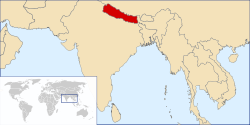This article provides insufficient context for those unfamiliar with the subject. (September 2024) |
| District Coordination Committee जिल्ला समन्वय समिति | |
|---|---|
| |
 Districts of Nepal wich governed by the Coordination Committee | |
| Location | Nepal |
| Created |
|
 |
|---|
|
|
| This article is part of a series on |
| Administrative divisions of Nepal |
|---|
 |
| Federal Democratic Republic of Nepal (since 2015) |
|
Nepal Portal Administrative divisions by country |
The District Coordination Committee (Nepali: जिल्ला समन्वय समिति, abbreviation: DCC) was formed on March 14, 2017, to replace the existing district development committee.[1][2] Each of the 77 districts in Nepal have their own district coordination committees in.[3]
The Head of a district development committee is elected by the district assembly. The government also appoints a Local Development Officer in each district development committee who heads the DCC in absence of an elected head or deputy head.[4]
The DCC acts as an executive to the district Assembly. The DCC coordinates with the Provincial Assembly to establish coordination between the Provincial Assembly and rural municipalities and municipalities and to settle disputes, if any, of political nature. It also maintains coordination between the provincial and Federal government and among the local bodies in the district. It also monitors development within the district.[5]
See also
References
- ^ "New local bodies operational in Province 1". thehimalayantimes.com. March 16, 2017. Retrieved 2017-07-07.
- ^ Rastriya Samachar Samiti (March 29, 2017). "Jumla locals pleased with new local set up". thehimalayantimes.com. Retrieved 2017-07-07.
- ^ "Official websites of District Coordination Committees | Ministry of Federal Affairs and Local Development". mofald.gov.np. Retrieved 2017-07-07.
- ^ Samata, Sapkota. "जिविसहरुको सम्पर्क विवरण | सङ्घीय मामिला तथा स्थानीय विकास मन्त्रालय". mofald.gov.np (in Nepali). Retrieved 2017-07-07.
- ^ "Constitute". www.constituteproject.org. Retrieved 2017-07-07.








